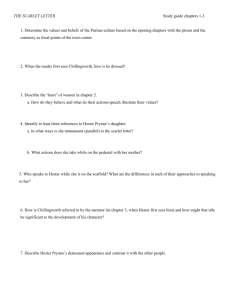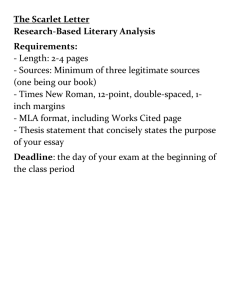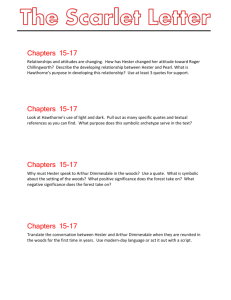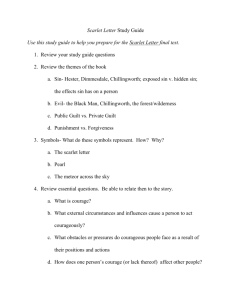The Scarlet Letter Essay Test Chapter 1
advertisement
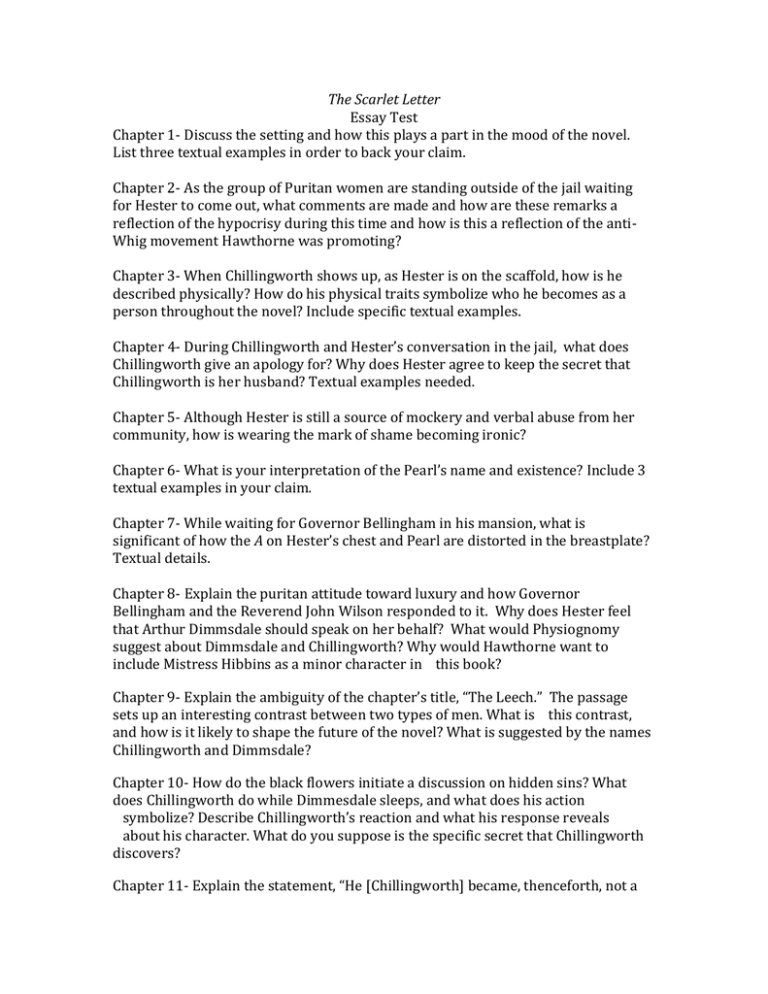
The Scarlet Letter Essay Test Chapter 1- Discuss the setting and how this plays a part in the mood of the novel. List three textual examples in order to back your claim. Chapter 2- As the group of Puritan women are standing outside of the jail waiting for Hester to come out, what comments are made and how are these remarks a reflection of the hypocrisy during this time and how is this a reflection of the antiWhig movement Hawthorne was promoting? Chapter 3- When Chillingworth shows up, as Hester is on the scaffold, how is he described physically? How do his physical traits symbolize who he becomes as a person throughout the novel? Include specific textual examples. Chapter 4- During Chillingworth and Hester’s conversation in the jail, what does Chillingworth give an apology for? Why does Hester agree to keep the secret that Chillingworth is her husband? Textual examples needed. Chapter 5- Although Hester is still a source of mockery and verbal abuse from her community, how is wearing the mark of shame becoming ironic? Chapter 6- What is your interpretation of the Pearl’s name and existence? Include 3 textual examples in your claim. Chapter 7- While waiting for Governor Bellingham in his mansion, what is significant of how the A on Hester’s chest and Pearl are distorted in the breastplate? Textual details. Chapter 8- Explain the puritan attitude toward luxury and how Governor Bellingham and the Reverend John Wilson responded to it. Why does Hester feel that Arthur Dimmsdale should speak on her behalf? What would Physiognomy suggest about Dimmsdale and Chillingworth? Why would Hawthorne want to include Mistress Hibbins as a minor character in this book? Chapter 9- Explain the ambiguity of the chapter’s title, “The Leech.” The passage sets up an interesting contrast between two types of men. What is this contrast, and how is it likely to shape the future of the novel? What is suggested by the names Chillingworth and Dimmsdale? Chapter 10- How do the black flowers initiate a discussion on hidden sins? What does Chillingworth do while Dimmesdale sleeps, and what does his action symbolize? Describe Chillingworth’s reaction and what his response reveals about his character. What do you suppose is the specific secret that Chillingworth discovers? Chapter 11- Explain the statement, “He [Chillingworth] became, thenceforth, not a spectator only, but a chief actor, in the poor minister’s interior world.” What is ironic about Dimmsdale’s incredible success as a minister? What is ironic about Hawthorne’s Portrayal of the Puritan society, in terms of this developing theme? Chapter 12- How is the episode of Dimmsdale’s midnight vigil on the scaffold structurally significant? Although Governor Winthrop is merely mentioned in the book, why would Hawthorne choose this night as the night Dimmsdale stands on the scaffold with Hester and Pearl? Chapter 13- Compare the feelings of the general public to those of the community leaders regarding Hester Prynne. Explain why the groups view her differently. Explain the statement: “It is remarkable, that persons who speculate the most boldly often conform with the most perfect quietude to the external regulations of society. The thought suffices them...” Compare the initial intent behind the scarlet letter to the actual effect on Hester. Chapter 14- How is the doctrine of predestination reflected in this conversation between Hester and Chillingworth? Why does Chillingworth believe he has a double reason for punishing Dimmsdale? Chapter 15- What is Hester coming to realize is the true sin she has committed? Why would Hawthorne consider this a worse sin than her sin with Dimmsdale? What does Hester realize about her “repentance”? How have Hester’s conversations with Chillingworth and Pearl changed her attitude toward herself and her sin? Chapter 16- Explain the significance of the sunlight imagery. Explain the probable allusion in the line “the minister and she would need the whole wide world to breathe in.” What positive significance does the forest begin to take on? What negative significance does the forest begin to take on? Chapter 17-Explain the distinction Dimmsdale makes between penance and penitence. Do you believe Hester is to blame for Dimmsdale’s suffering during the past seven years? Why or why not? What theme about nature of sin finally begins to emerge in Hester and Dimmsdale’s conversation? Here is a key question for Hawthorne and the Anti-Transcendentalists: can a “polluted soul” do good for others? Chapter 18- What is significant about the title of this chapter? How does Hawthorne reinforce his idea that nature is sympathetic with the union of Hester and Dimmsdale? Chapter 19- What is significant about the fact that Pearl will not bring her the scarlet letter, but makes her pick it up for herself? This chapter begins on the same optimistic note that ends the previous chapter. On what kind of note does the chapter end? Why? Chapter 20- In terms of Hawthorne’s theme contrasting hidden sin versus revealed sin, how can you explain Dimmsdale’s change in this chapter? Why is the chapter called “The Minister in a Maze”? Chapter 21- Compare these first-generation New Englanders with their recent English ancestors and with their future New England descendants. What distressing news does Hester receive from the ship captain? Chapter 22-What is the source of Dimmsdale’s apparent new strength? What does Pearl want from Dimmsdale? Explain the remarks, “The sainted minister in the church! The woman of the scarlet letter in the market-place!” What clues has Hawthorne offered his reader to prepare him or her for the revelation of the scarlet letter on his chest? Chapter 23-Why does Dimmsdale stand “on the very proudest eminence of superiority” before the crowd? What does Chillingworth mean when he says, “There was no one place...where thou couldst have escaped me—save on this very scaffold!” In what way is Dimmsadale’s sin worse than Hester’s? Of Hester, Chillingworth, and Dimmsdale, whose sin is the worst? Why? What accounts for the change in Pearl? Chapter 24- Why does Hawthorne leave the origin of Dimmsdale’s mark ambiguous? What happens to Chillingworth? What does he give Pearl?Why do you suppose Hester returns to Salem? What might be Hawthorne’s point about sin, repentance, and redemption? Why would Hawthorne allow the story to end with Hester and Dimmesdale being remembered so ignominiously?

